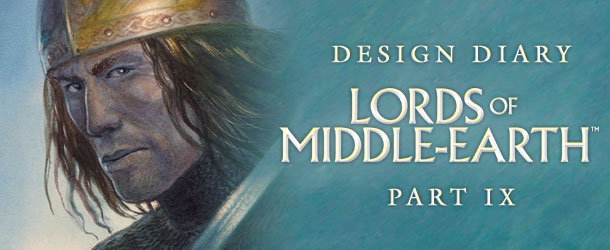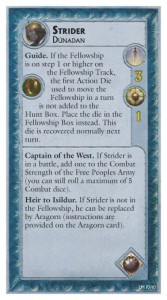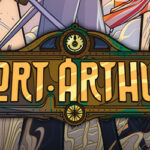Strider is definitely one of the most important characters in War of the Ring.
In the Fellowship, he opens the way to one of the “extreme” strategies that the Free Peoples player may use, the “Strider Sprint”, which uses his power as a Guide (hiding the Fellowship with any die) to get the Ringbearer to move towards Mordor using almost all the Action Dice available.
At the same time, separating him is also of utmost importance. “Upgrading” Strider to Aragorn, Heir of Isildur, gives to the Free Peoples player an additional die, which can be precious to swing the balance to his favour if this happens in the first turns of the game.
And an early death of Strider as a random casualty - no sane Free Peoples player would willingly eliminate him! – is a blow not easy to recover from.
It soon became clear that creating an alternate version of such an important character was a big challenge. The design of the alternate versions of most of the other Companions worked fine almost since the beginning. The only real change they had during development was that, initially, there was a “hidden setup”, so that the Shadow did not know if they were in the Fellowship or in their homeland. But their specific abilities did not change that much during playtest and development.
Gandalf was more difficult, as we said before. But the “new” Strider proved to be the toughest to re-define properly. The first versions of Strider just used a stronger variant of the Guide ability of the other Companions: instead of eliminating him, you could separate Strider when he was the Guide of the Fellowship. A stronger effect than removing one Corruption? Cancel one tile… But this proved to be definitely TOO good!
After all, differently from most of the other Companions, the Free Peoples player really WANTS Strider to be separated, as soon as possible. The new ability meant that you could get an early separation, avoid wasting a die, canceling a Hunt Tile… Why should you bother with the “old" Strider? Even “toning down” the effect (reducing two Corruption rather than one) was not an improvement. It was still too much a boon for the Free Peoples to be able to separate Strider from the Fellowship using the Guide ability, instead of an Action Die.
It was clear we had to change the reasoning behind the re-design of Strider. We should not follow the same logic as the other Companions, and in fact, the logic should be reversed.
In the basic game, unless you’re doing a Strider Sprint (which in 2nd Edition is not as good an option as it was before), you want Aragorn in play as soon as possible. So, the new Strider should provide a greater incentive to keep him in the Fellowship, rather than hastily replacing him. However, the “old” Strider already had a good ability as a Guide. What could we do differently, to create an interesting new version?
The first idea was to have a new effect influencing the chances of the Fellowship being revealed. Rather than allowing you to hide a revealed Fellowship, it would prevent a Reveal on the Fellowship (only when provoked by a “normal” Hunt tile), by spending an Action die. However, such an effect was too similar to his "old" ability, and had the negative side-effect that was a perfect counter to the new Witch-king. The Chief of the Ringwraiths can only enter play, in practice, after the Fellowship is revealed for the first time. It looked a little pointless to add two new characters who cancel out each other. So we started looking for something different.
Of course, a Guide ability must influence the Hunt. What else could the new Strider do?
We realized that the Free Peoples player never has a chance to directly influence the strength of the Hunt roll. The Shadow player has ways to enhance his roll; and with the new Witch-king and his ability to relentlessly pursue the Fellowship, even more than before. The Free Peoples player cannot do anything to reduce the risk of the Hunt roll.
We realized that giving to the Free Peoples player this possibility could be a great new way to represent the efficacy of Strider as a ranger who leads the Fellowship to avoid dangers.
The ability we designed for Strider is that the first die used to move the Fellowship in a turn does not go into the Hunt box, if Strider is the Guide. As each time a Free Peoples Action die goes into the Hunt box, the Hunt roll improves by +1, this means that - with Strider guiding - the Fellowship can move twice in a turn, and the second movement is still only as dangerous as the first.
At the same time, however, if the Fellowship only moves once, there will be no Free People dice in the Hunt box at the end of the turn: This implies that, in the next turn, the Shadow player can decide to leave zero Eyes in the Hunt, and if Gandalf the Grey, Bearer of Narya, becomes the Guide, his ability does not work.
So, the new Strider introduces an interesting situation: the Fellowship can move faster without increasing the risk as much as before, but it is more difficult to stay hidden than with the "old" Strider, and the Shadow player draws a little benefit from a slow-moving Fellowship.
Sprinting against a lot of Eyes in the Hunt box remains risky, so Corruption strategies are not ruled out. With Strider in the Fellowship, the Shadow player may also play “Gandalf the White Denial” (that is, not playing Saruman or the Black Captain, to prevent the White to be mustered) and force the Free Peoples player to choose between playing with 4 dice, or separating Strider. A “Strider Sprint” strategy becomes indeed viable again, but the Shadow player has ways to counter it.
The ability is indeed very strong, but the trade off is that Strider in the Fellowship means one Action die less in the pool of the Free Peoples player, as Aragorn is not around. Is the trade off a good one? It’s a difficult choice… Exactly as it should be!
The new Strider worked well in the playtest. With this last character completely defined, the design of Lords of Middle-earth was finally complete… And so our series of Designer’s Diaries is finally close to the end.
In the next and final article… a few notes about Events, good-byes, thanks and the complete rules!












Follow Us on